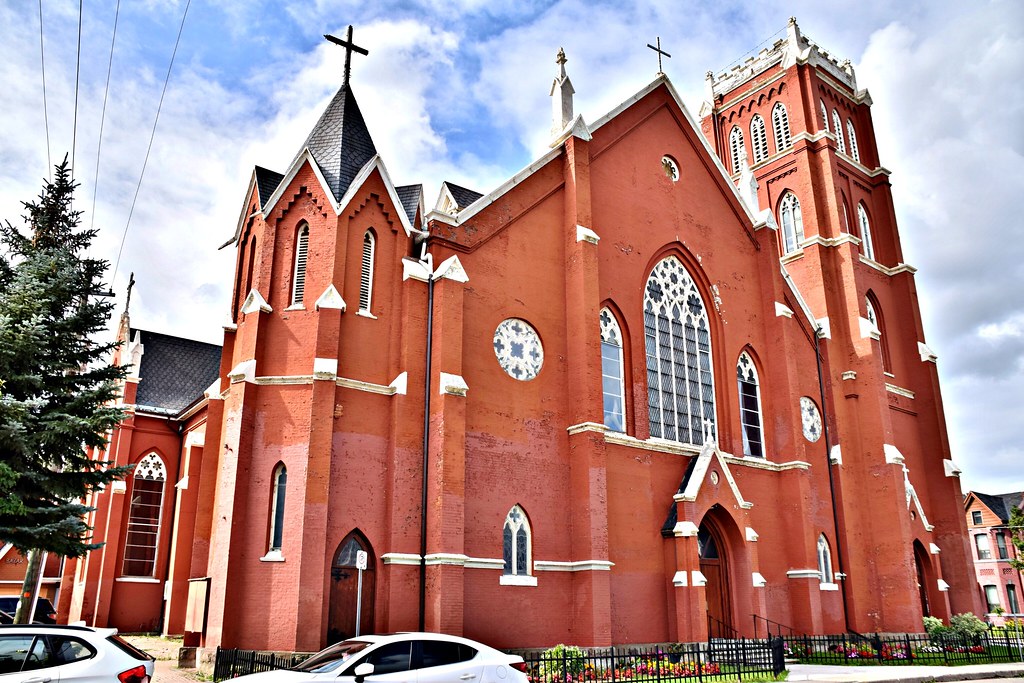
Diocese of Hamilton
The Diocese of Hamilton was established on February 29, 1856 by Pope Pius IX as a division of the Archdiocese of Toronto. The first Bishop was the Right Reverend John Farrell; installed on May 24, 1856. The Hamilton Diocese has grown to become the second largest English-speaking Roman Catholic Diocese in Canada, encompassing the Counties of Brant, Bruce, Grey, Halton, Waterloo, Wellington, and four Townships in the County of Dufferin. There are currently 126 parishes in the Diocese, with the inspiring Christ the King Basilica, built in 1933, as the Cathedral. The Diocese of Hamilton has flourished through the leadership of its Bishops and the faith of its clergy, religious communities, and dedicated parishioners. The Diocese is proud to celebrate its rich history and cultural diversity.
Text adapted from “A Short History of the Roman Catholic Diocese of Hamilton” by Rev. Edward J.R. Jackman, o.p.
Click on the links below to learn more about the history of the Diocese of Hamilton.
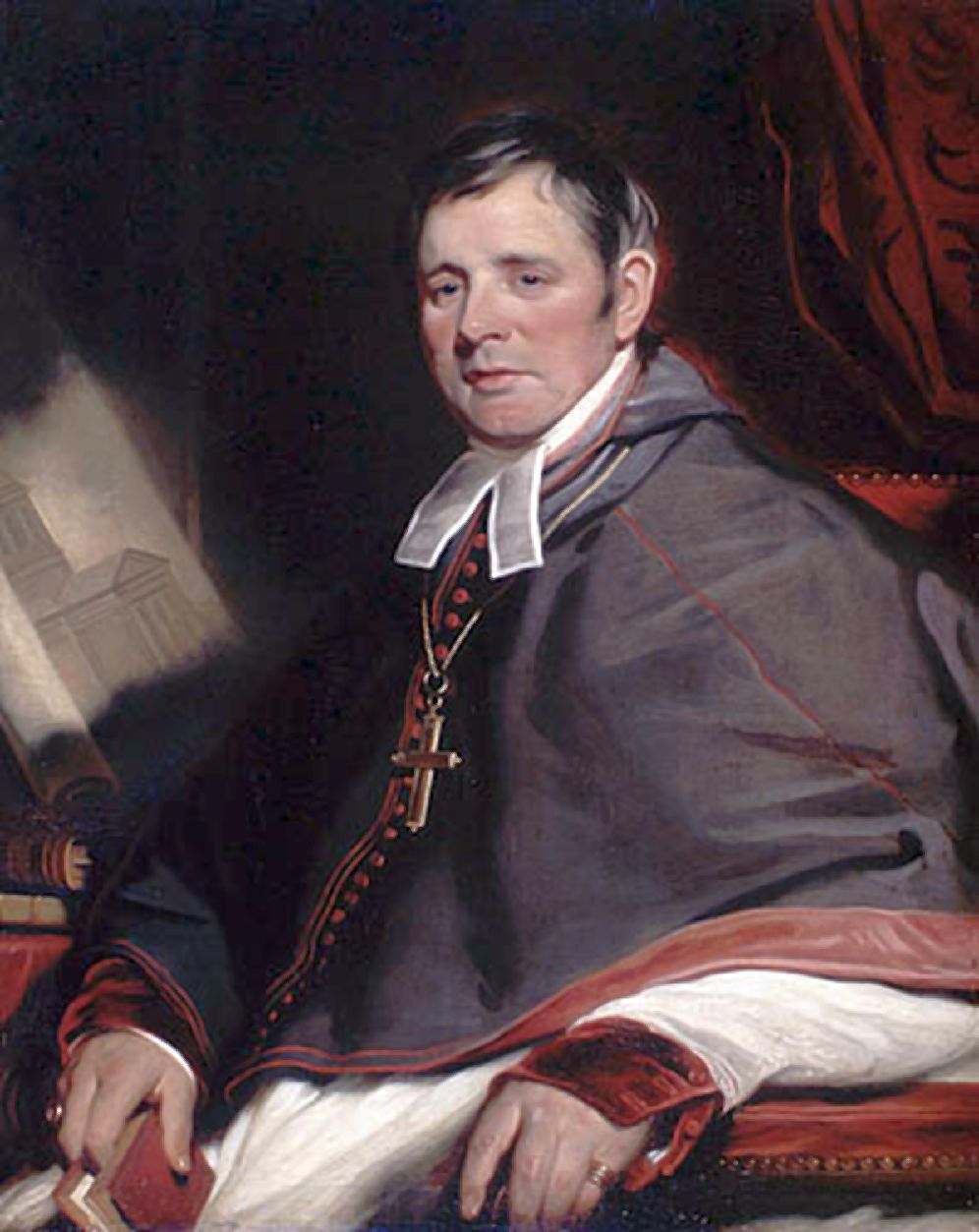
Painting: Bishop Alexander Macdonell - First bishop in Ontario 1826-1840
Credit: Library and Archives Canada
Over the centuries, the Roman Catholic Church spread its influence first to Europe and then to the other continents of the world especially after about the year 1500. From 1600 onwards, missionaries from France began to visit what is now Ontario, and eventually our own territory, the Diocese of Hamilton. The missionaries, usually Franciscans or Jesuits, said Mass and began to spread the Gospel of Jesus Christ among the native peoples.
By the late 1700s settlement of Southern Ontario began in earnest under the British colonial regime. In what was to become the area of the Diocese of Hamilton today, small settlements began along the major lakes and rivers over a swath of land in mid-western Ontario stretching from Lakes Erie and Ontario in the south to Lake Huron and Georgian Bay in the north. To meet the spiritual needs of these newly arrived settlers, traveling missionary priests visited the people occasionally to say Mass and administer the Sacraments in both public buildings and private homes.
These priests were assigned first to the Dioceses of Québec, then Kingston, and finally Toronto, all of which at one time or another encompassed the present-day Hamilton Diocese. At first the priests were French, later Scottish and Irish, as Upper Canada (Ontario) developed its identity separate from that of Lower Canada (Québec). Most prominent among these early clergy was the Scotsman, Bishop Alexander Macdonell from Glengarry and Kingston. As the first bishop in Ontario from 1826 to 1840, he worked with the colonial authorities to establish parishes and churches in this province of pioneers.

Photo: St. Augustine, Dundas - Established in 1826, St. Augustine’s is the oldest parish in the Diocese of Hamilton
Credit: Bochsler Studios Photography
Some of the first Catholic churches were established in places such as Oakville, Dundas, Brantford, and Guelph. Priests were expected to reside at these locations, build a church and visit the people usually on horseback in the surrounding territory, often the size of a present-day county such as Wentworth or Wellington. Mass was said as regularly as possible in a few major locations but the Sacraments of Baptism, Marriage and Confession often had to be delayed until the priest was next able to visit the more distant smaller communities.
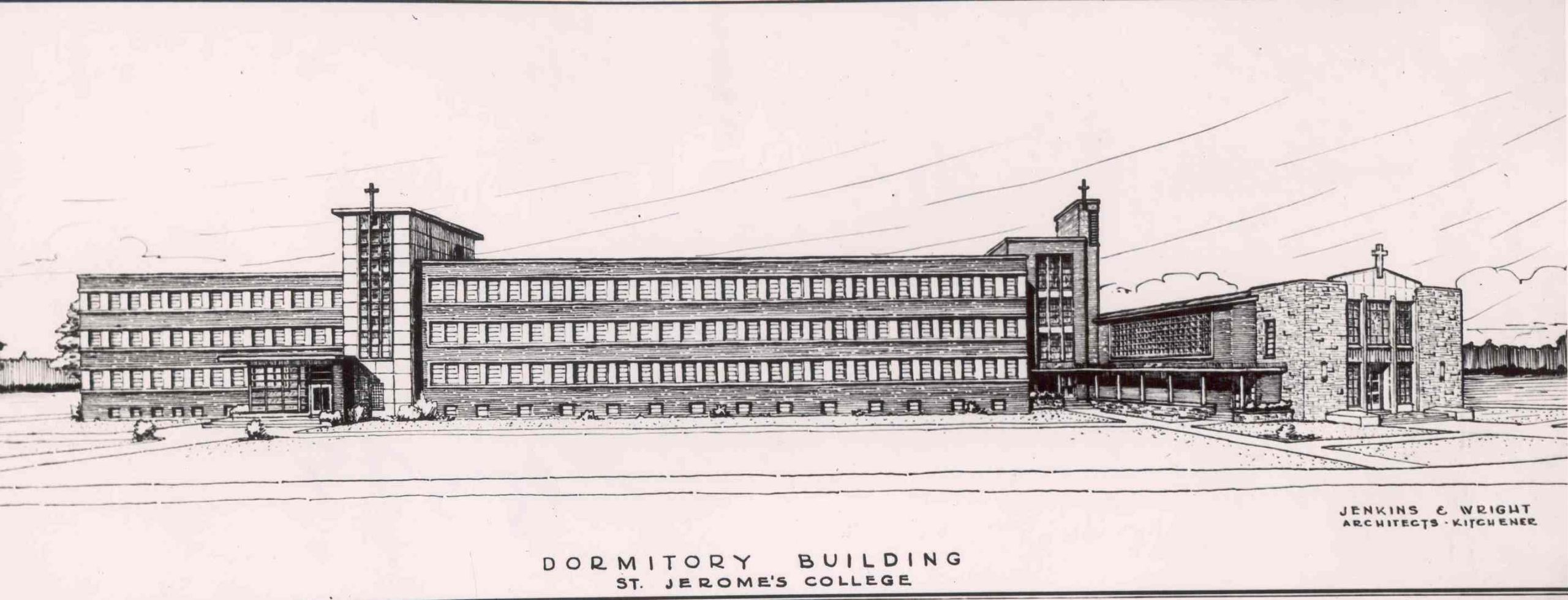
Illustration: St. Jerome's was founded by the Resurrectionist Rev. Louis Funcken to serve Roman Catholics in Waterloo County
Meanwhile, immigrants continued to pour into the new province from the 1820s to the 1840s. They often came on planned immigration schemes, and though life in the new world was difficult, the spiritual needs of the people were never neglected. Bishops and priests saw to it that the ever expanding number of new settlements received pastoral care, no matter how remote the settlement might be, or how difficult it was to reach. In the late 1840s the Catholic population of Ontario, and particularly our area, greatly increased. Two major events were the cause of this. Firstly, in Ireland there was the great potato famine from 1845 to 1849, which drove millions out of their native land. Ontario received large numbers of Irish and soon the Catholic population had doubled. Secondly, in 1848, political troubles in Europe forced large numbers of German-speaking peoples to seek freedom in the new world. They would make their first home in Waterloo County and later spread to the north-west into Bruce County. They were served by the Fathers of the Resurrection who came from the United States. Of particular significance was their founding of St. Jerome’s College in Waterloo County. In 1852, the Jesuit fathers arrived in the Guelph area and ministered to families in the surrounding region, a presence that continues to this day.
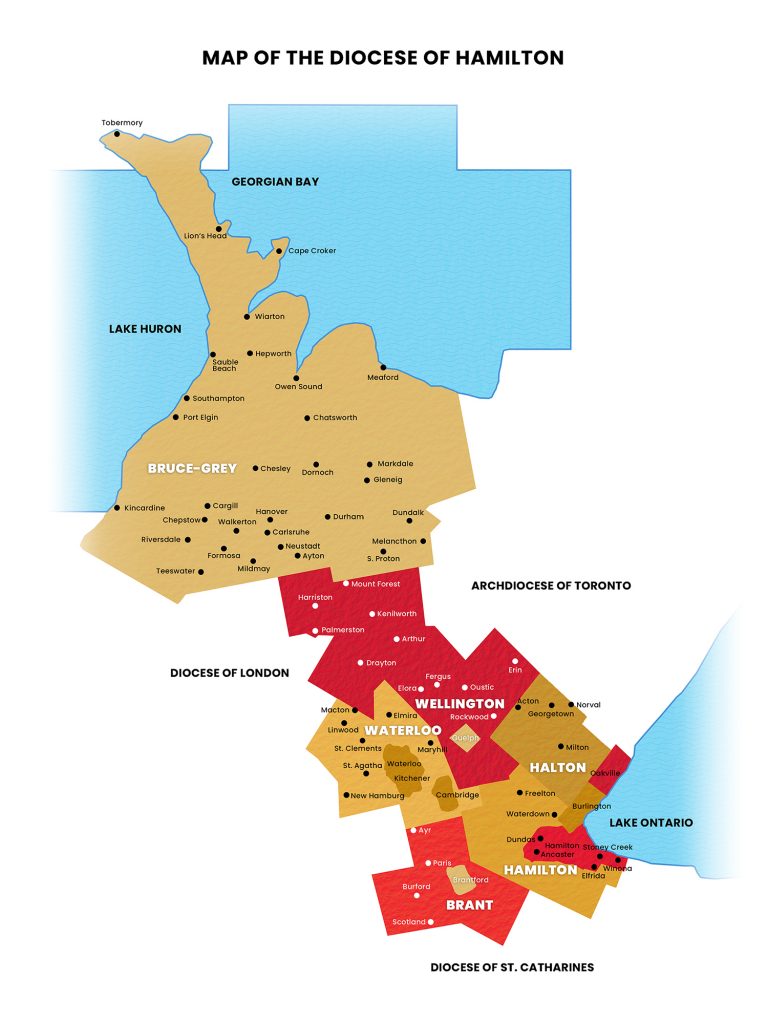
Illustration: Map of the current boundaries of the Diocese of Hamilton
To meet the pastoral needs of our ever-growing Catholic community, the Vatican decided to create new dioceses in Ontario so that there could be better ecclesiastical supervision of the many new parishes and their peoples. Thus, on February 29, 1856 the Dioceses of Hamilton and London were formed from portions of the Diocese of Toronto.
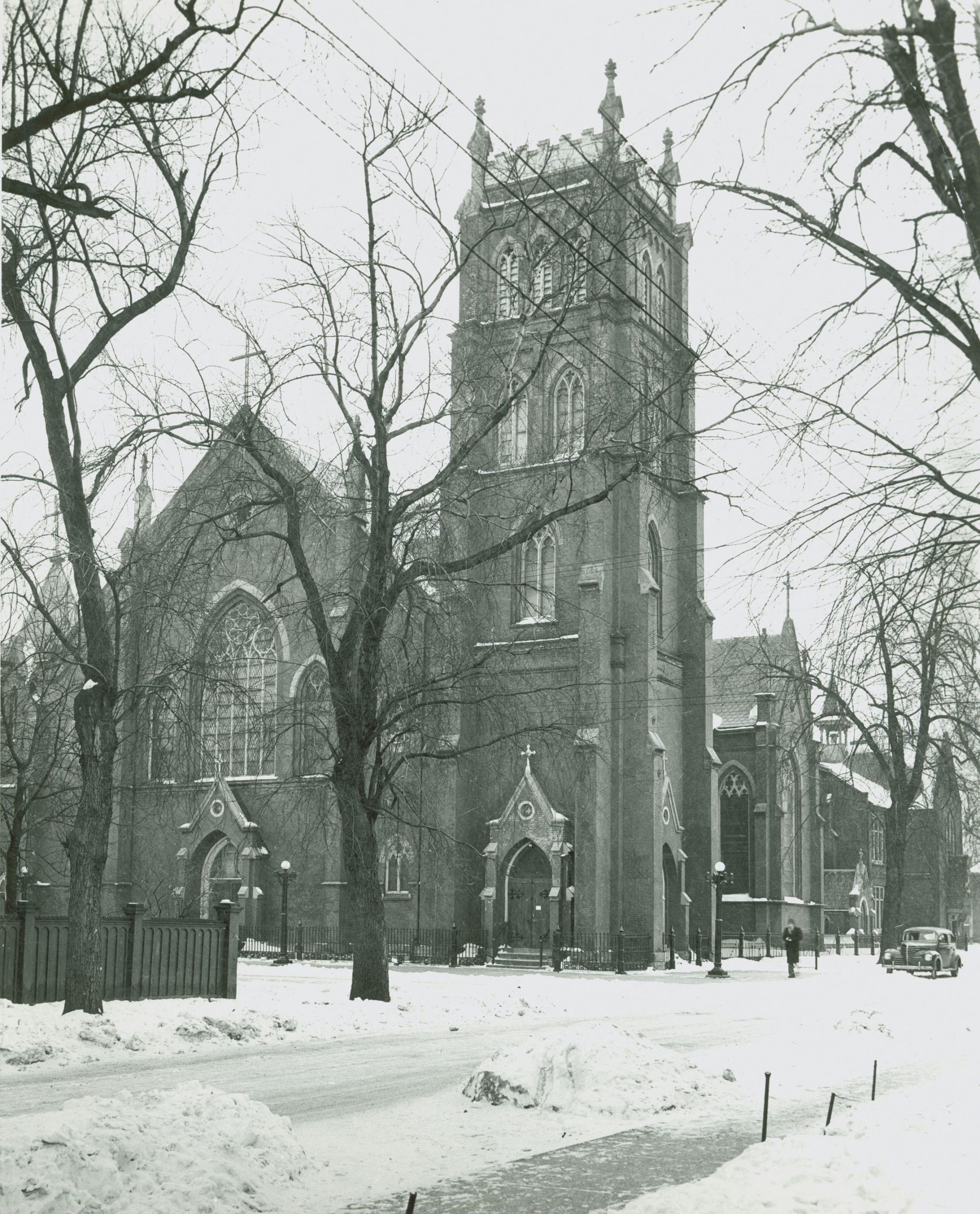
Photo: St. Mary, Hamilton - The first cathedral for the diocese
The first Bishop of the Diocese of Hamilton, Most Reverend John Farrell was consecrated a bishop in Kingston on May 11, 1856, and shortly afterwards was installed as the Bishop of Hamilton at the city’s only Catholic Church, St. Mary’s. In his first pastoral letter issued that same month, he named as the patron of the Diocese the “...Ever Glorious and Blessed Virgin in the mystery of the Annunciation”. After a fire destroyed the wooden church, Bishop Farrell built the present St. Mary’s in 1859 and 1860 as his new cathedral, in whose vault he and two of his successor bishops are buried. St. Mary’s, today, strikingly and proudly remains our first cathedral. St. Patrick’s Church, built in Hamilton in the 1870s, also briefly served as the cathedral, while Bishop John McNally, D.D. built our current Cathedral of Christ the King.
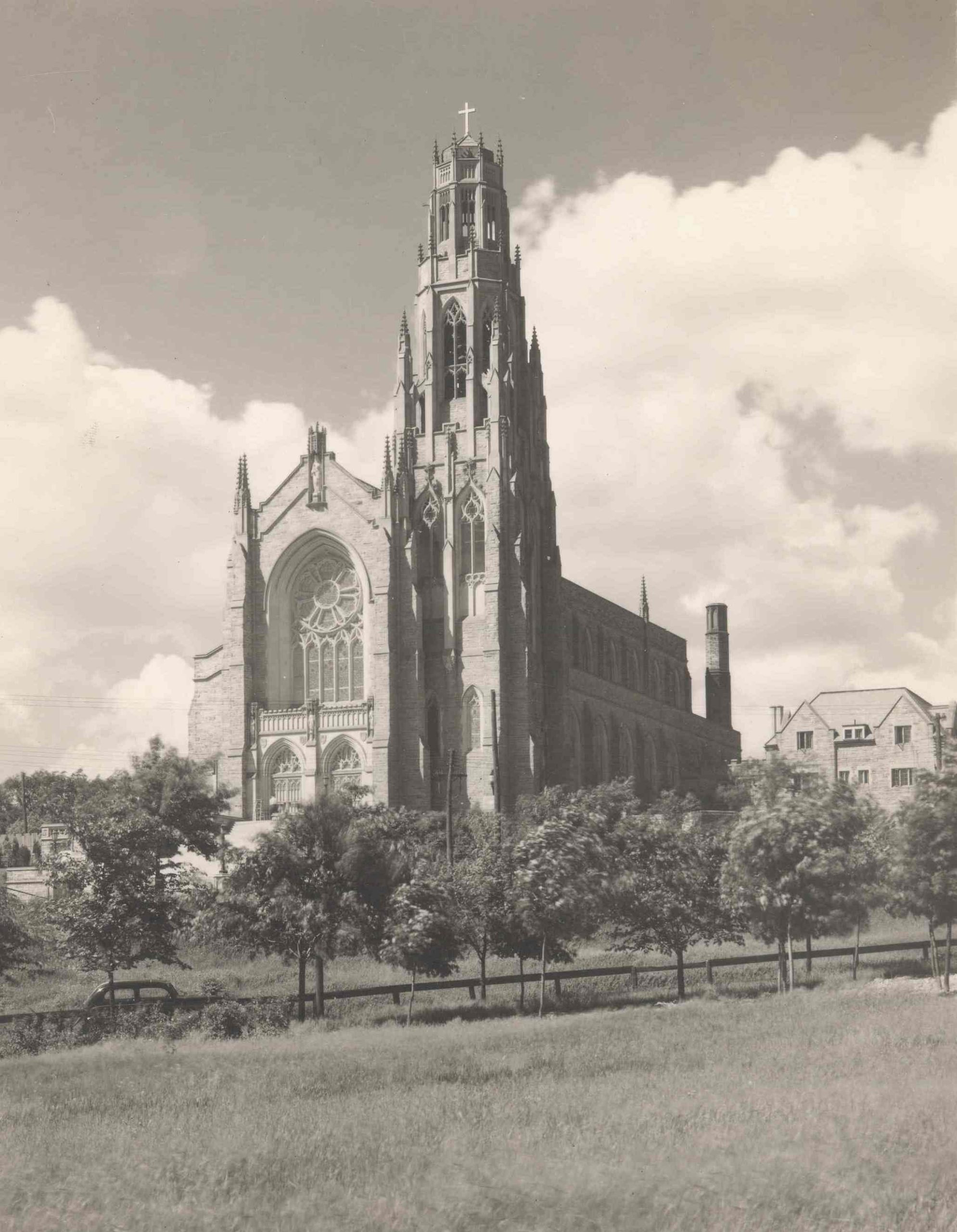
Cathedral Basilica of Christ the King, Hamilton -
The current cathedral, built in 1933

Photo: St. Mary, Hepworth. A mission of St. Mary of the Assumption, Owen Sound
Credit: Bochsler Studios Photography
There was a great deal of reorganization, consolidation, and expansion during the 1850s and 1860s in order to implement the new diocesan structures. Of greatest importance was the need to obtain more priests to serve in the growing network of parishes. There was also a need for religious sisters to help found schools, hospitals and other charitable institutions that were so desperately needed by the struggling immigrant communities. By the 1870s and 1880s the diocese had expanded to its northern limit, Tobermory. Parishes would spawn mission churches, which in turn became new parishes themselves with a resident priest. This process repeated itself many times. Greatly helping in this expansion was the building of the railways throughout the diocese, which now comprised the eight counties of Haldimand, Brant, Wentworth and Halton in the south, Waterloo and Wellington in the middle, and Bruce and Grey in the north. Priests and people could now travel with ease throughout the diocese and the conveniences of modern living could be brought great distances. Thus, some very fine churches were built even in the most remote areas of the diocese.
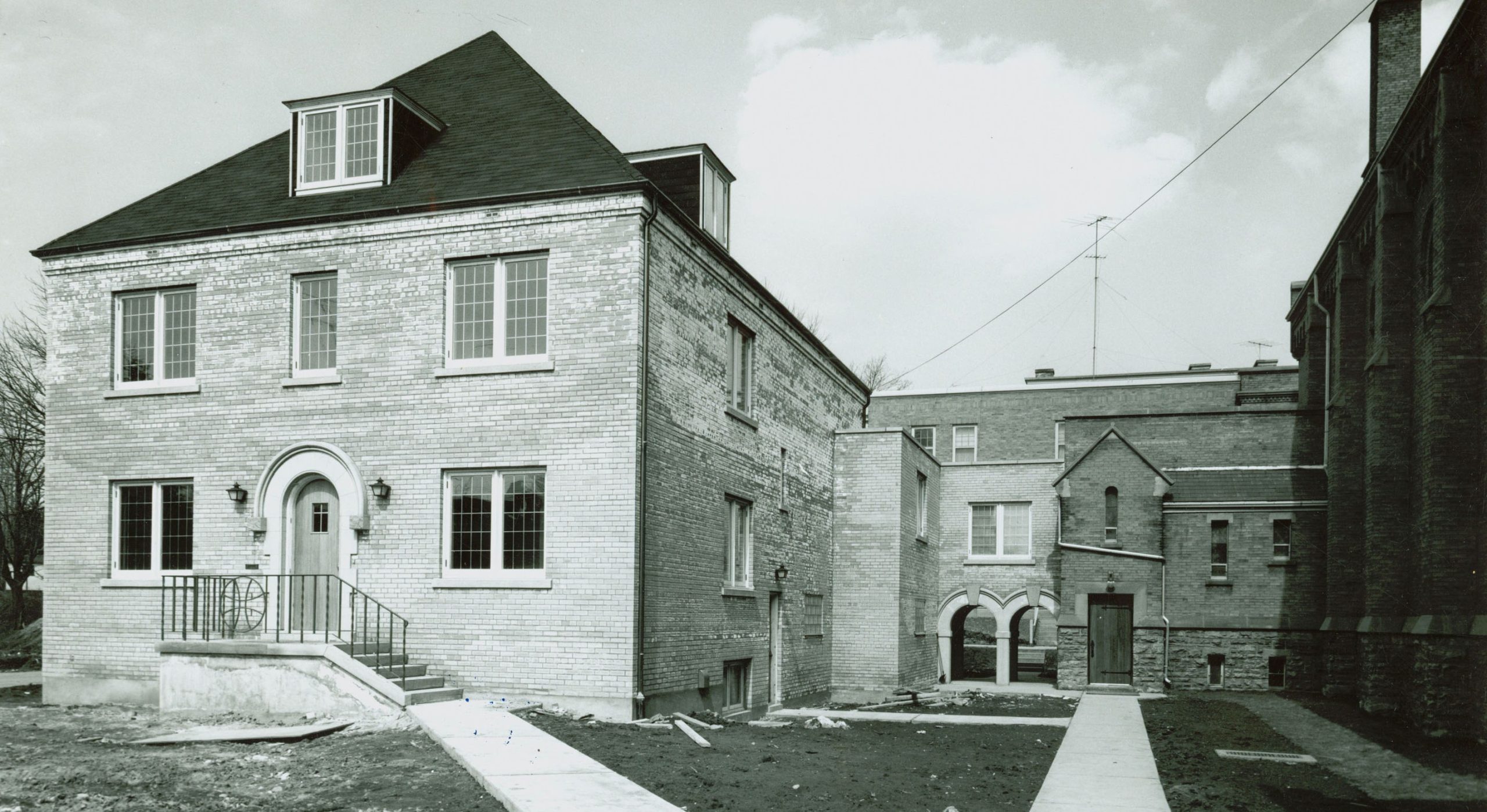
Photo: Rectory at Sacred Heart, Kitchener
In 1912 the Polish community in Kitchener was given blessing to form a parish
By the final decades of the 19th century and into the 20th century, the nature of the diocese had begun to change. Industrialization had taken place, led by the City of Hamilton itself which became the leader of steel production in Canada. The cities in the southern and central parts of the diocese began to expand rapidly. Huge numbers of new workers arrived with their families and their needs had to be taken into account. New churches, schools and a host of charitable institutions were needed. Many of the new immigrants were of a different ethnic background from the original Irish and German peoples, who were the most numerous in the diocese during so much of the 19th century. Other Catholic peoples began to arrive from Europe in large numbers. The first to arrive were the Italians, the Polish, and the Ukrainian peoples. They often built their own churches, served by their own clergy.

Photo: Sister of St. Joseph demonstrating x-ray equipment at St Joseph’s Hospital, Brantford
The Sisters of St. Joseph specialized in the realms of health care and education
The early 20th century was also a time of increasing specialization in the work of the Church. Religious orders came to do specific tasks. Examples are the Jesuits and Resurrectionists, who worked in education and parishes, and the Basilians, who served many missions in the northern part of the diocese from their parish church in Owen Sound. The Sisters of St. Joseph taught in separate schools and were hospital administrators and nurses. The School Sisters of Notre Dame also taught at all three levels of education and established Notre Dame College Residence at what was later to become part of St. Jerome’s University.
Above all, the period before the First World War was a time of consolidation, stabilization, and proud triumphalism as exemplified by the church worldwide at that time. Many of the oldest churches and institutions, which we see today, date from this period and are still standing strong.
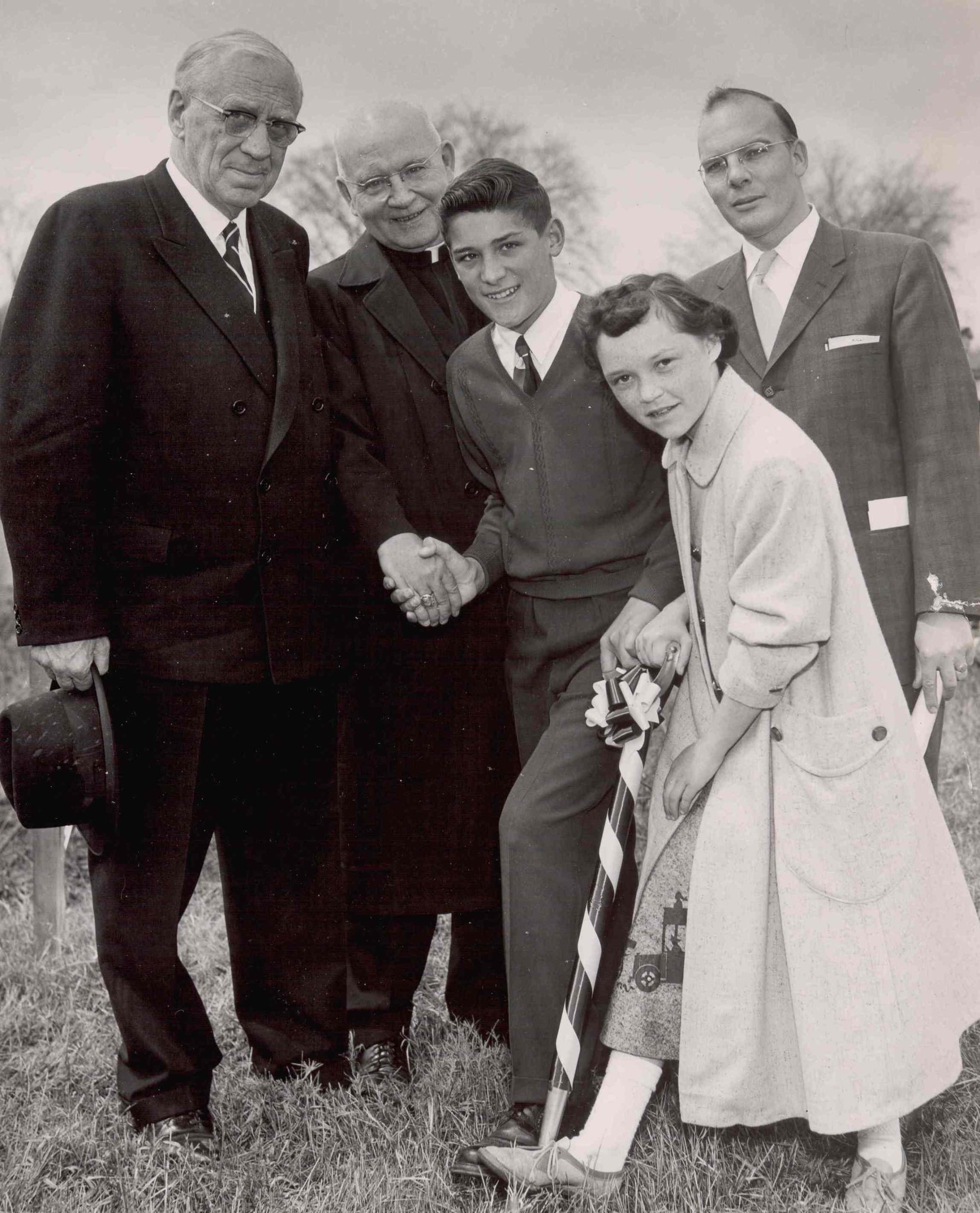
Photo: Bishop Ryan, Mayor Lloyd Jackson, and T.J. McKenna at the Ground-Breaking of Bishop Ryan High School
During the First World War (1914 to 1918) and the Second World War (1939 to 1945) our people volunteered in large numbers for the military and our priests served as chaplains. After both wars there was extensive suburban expansion around the big cities. Many new churches were built. Their architectural style differed substantially from that of the traditional 19th century Gothic structures.
Of particular importance to the diocese, during the post-Second-World War era was the episcopacy of Bishop Joseph Francis Ryan. A true native son, he was the bishop of Hamilton from 1937 to 1973. During the 1950s and 1960s there was a major influx of immigrants from war-devastated Europe and a very high birth rate from Canada. Bishop Ryan opened more than 50 new parishes, thus doubling their existing number. Bishop Ryan was also very influential in the expansion of the new school systems both on the practical front of assisting in the building of many new schools and also on the political front, in obtaining more rights and funding for Catholic education, at all levels, from the Ontario government. Many new religious orders also entered the diocese during this same period, a time of exceptionally numerous vocations to the priesthood and religious life. Devoted to the contemplative life were the Precious Blood Sisters who established a presence in Hamilton in 1946, followed by the Carmelite Sisters in Kitchener in 1952. Many religious communities came to work specifically with the poor and downtrodden such as the Sisters of Social Service and the Brothers of the Good Shepherd.
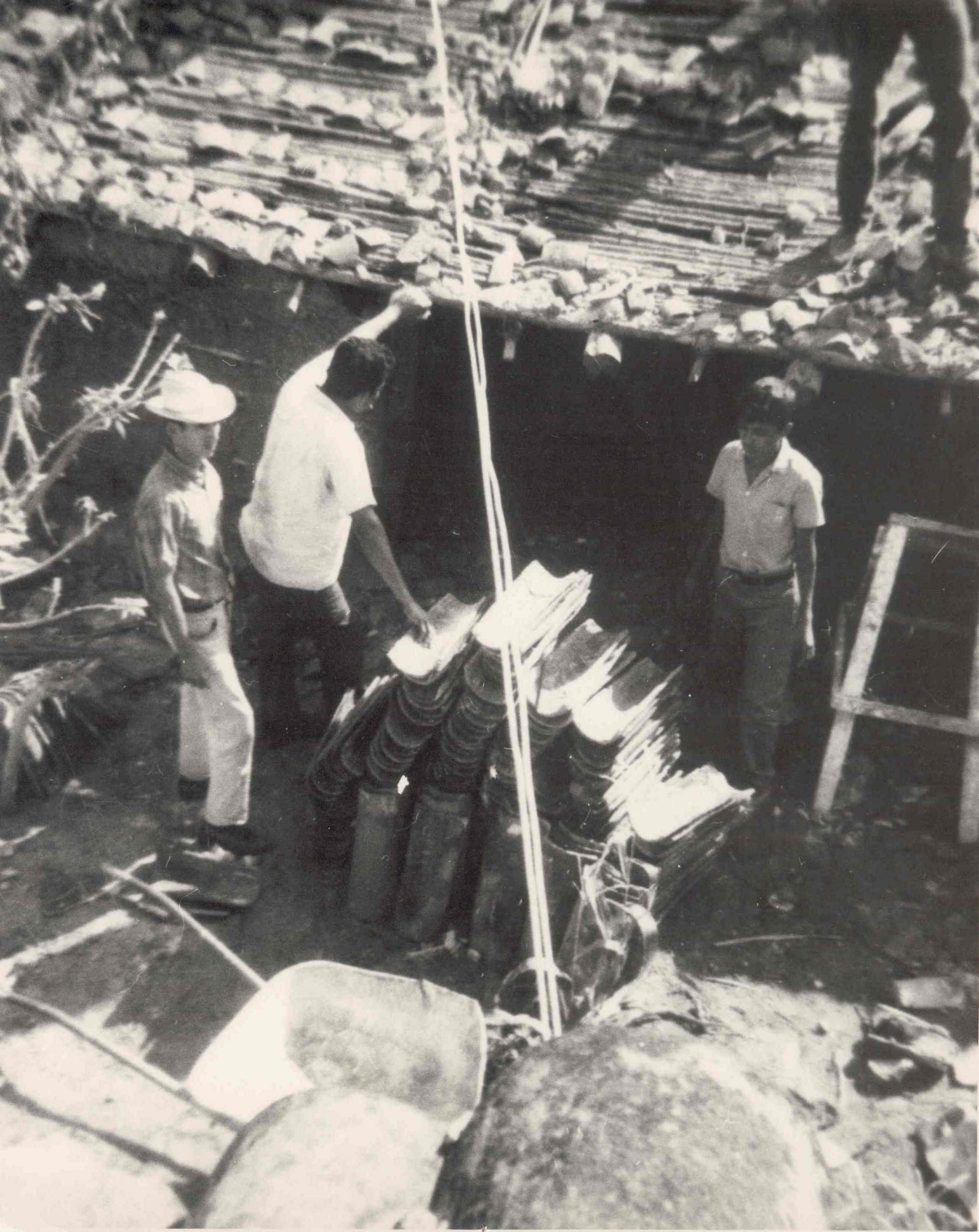
Photo: Fr. Mike Myroniuk working in Guatemala
From 1962 to 1965 the Second Vatican Council took place in Rome. Since then, the church throughout the entire world has had a decidedly different look about it. Not only did church architecture change but the way in which the church carried out its mission changed. The laity began to play a much larger role in church life; the Mass was now said in the local languages rather than in Latin, and in general the church became more pastoral in its approach to the people. True to the spirit of the Council and to the church’s inspiration by the Holy Spirit at Pentecost, the Diocese of Hamilton went from being a receiving diocese to being one that sent forth its own missionaries. Thus, from 1962 to 1981, priests and sisters were sent out from the diocese to serve in the Guatemalan Diocese of Zacapa, where the needs were and still are much greater than anything we have experienced here at home.
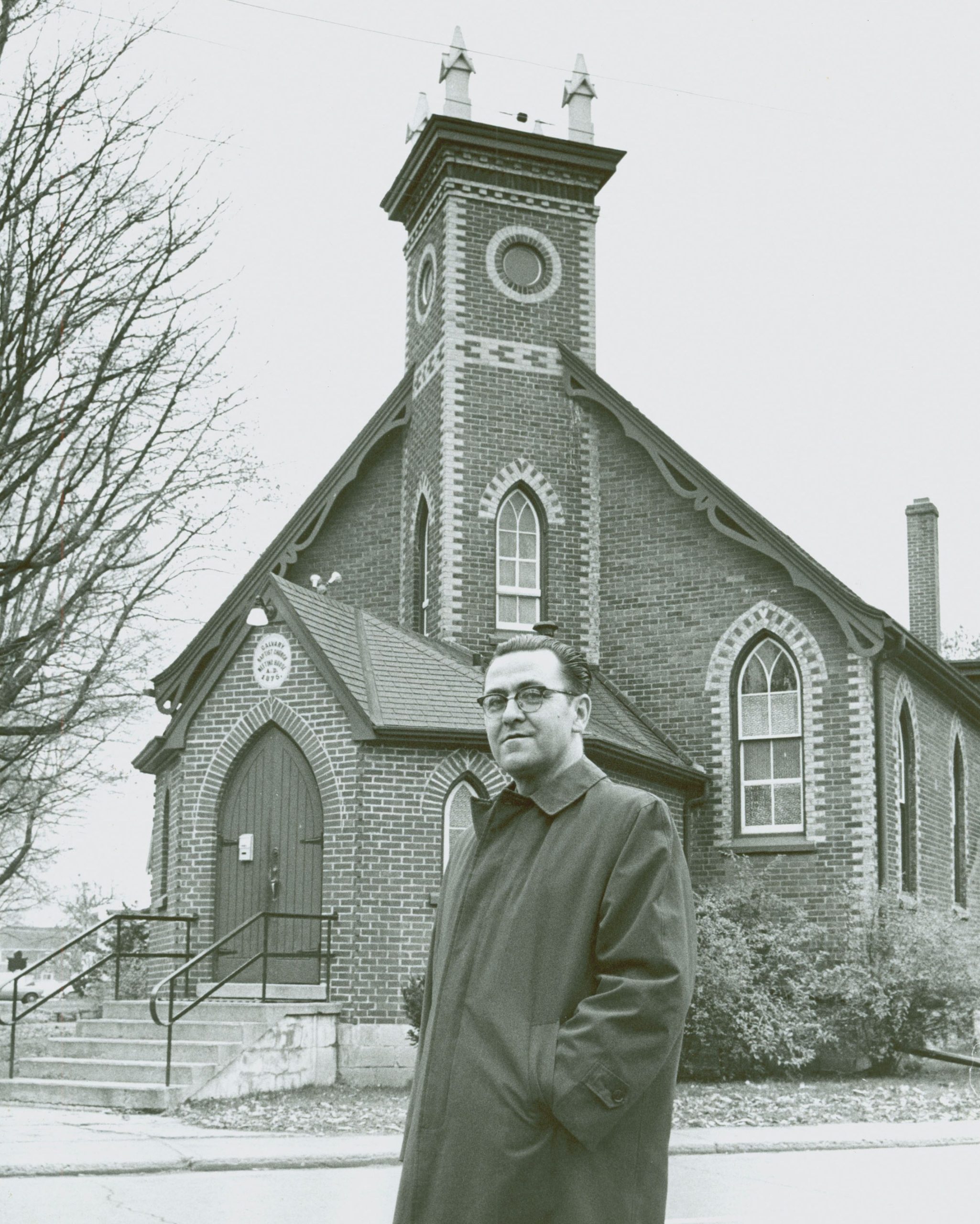
Photo: Fr. Benoit Boulanger in front of St. Philippe church in Burlington
St. Philippe’s parish was founded in 1968 to meet the needs of the French-Canadian families in the Burlington area
Credit: Photograph courtesy of The Catholic Register
By the late 1960s Canada had embraced a policy of bilingualism and multi-culturalism. People from all continents of the world began to flow into Canada during the tenures of Bishop Ryan and Bishop Paul Francis Reding. This would result in English-language parishes with peoples from some fifty or more different linguistic and ethnic groups. Many “national” parishes, from French to Korean, were now established or had been established long since. Diversity was already a strong tradition in the diocese. As the church progressed to become more culturally diverse, there always remained a deep bond of unity as seen in our common loyalty to the teachings of the church and our love of Christ in the Eucharist.
Entering the 21st century, the diocese has taken particular care to ensure that the spiritual and social needs of all its people are met. In the years to come may we build with conviction and hope so that the journey begun here upon Earth will truly lead us into God’s kingdom in heaven.
Contact
Dominy Williams
Director
905-528-7988 Ext. 2252
Send Email
Anne Lamanes
Archival Assistant
905-528-7988 Ext. 2270
Send Email
